
A dental bridge is a cosmetic treatment to cover a missing tooth in patients mouth by using other neighboring teeth. Depending on the condition of the neighboring teeth, there are mainly two types of dental bridge treatment.
The typical and the most common treatment involves two crowns crafted from porcelain or metal, permanently bonded to patients original teeth on either side of the gap, with the artificial (false) tooth in the center. If the teeth on either side of the missing teeth are strong, healthy and have a good shape factor, it may be possible to have an adhesive bridge. An adhesive bridge is a artificial tooth with ‘wings‘ on either side. These wings are glued to the inner surfaces of the healty support teeth. This means that neighboring teeth do not need to be prepared for full crowns, making the treatment less invasive.
Dental bridges provide a long lasting solution for missing teeth, besides dental bridges are able to fill in gaps where teeth are missing without the need for implant screw surgery, unlike more costly and lengthy dental implant treatment. Additionally, by choosing porcelain finishes, your new tooth can closely resemble the natural teeth.
Having a dental bridge can increase patients self-assurance in your smile and simplify everyday tasks like eating and talking. Replacing a tooth that is missing can offer protection to your other teeth as well. Having empty spaces in your mouth can cause surrounding teeth to shift or tilt, impacting your ability to bite properly. Food may become stuck in crevices, raising the chance of developing cavities. Dental bridges are a commitment to your self-assurance, well-being, and dental wellness.
A dental bridge is a fixed feature and will function just like your natural teeth and the patient will not have any problems with eating or speaking. The materials we use are Porcelain Fused Metal (PFM) Crowns or Zirconia Porcelain Crowns and our laboratories use only the highest quality materials.
Dental Bridges Procedure
The procedure for dental bridges is simple and typically involves several steps as outlined above. Treatment stages may vary according to the patient’s condition. For example, shaving may not be performed for a patient who meets healthy and strong neighboring teeth.
Initial Consultation: The dentist will assess your dental needs in terms of decay, damage, or discoloration than take X-rays, and discuss the treatment plan. This step ensures that whether to use crowns on neighboring teeth.
Tooth Preparation: Especially in this method, If crowns will be used, the surface will be prepared to place the crowns. Local anesthesia is used to guarantee comfort during this procedure. However, in some cases, no-prep or minimal-prep may be an option, requiring less or no enamel removal, if the tooth alignment is correct and the neighboring teeth are strong and healty.
Impression: An impression is taken from your teeth to create a outline for the bridge or/and crowns. A temporary custom bridge is placed on the tooth to protect the prepared tooth surfaces while the permanent bridge is being made.
Fitting and Placement: When the bridge is ready for placement, the dentist will remove the temporary bridge which applied previous step for protective purposes, checks its harmony and color with other teeth, and then carefully paste it to the appropriate place. Minor adjustments may be made to ensure a perfect fit.
Before & After Photos
Dental bridges offer a transformative effect, enhancing both the function and vision of your teeth. Patients who undergo this treatment often experience improved confidence and a more beautiful smile. Below are some before and after photos showing the outstanding results of bridges, which were made in our clinic:




Frequently Asked Questions
You can use the section below for questions about dental bridges and the treatment process.
Yes, dental implants require a more laborious treatment process than dental bridges, although they are longer lasting and have a tooth-like root structure. If you do not want to opt for long-term and relatively expensive dental treatments, you can request dental bridges treatment method.
Absolutely! With the bridge connected to the neighboring surfaces, your speech will be indistinguishable from what it was before tooth loss. It will also look like any other tooth and you will regain your chewing function with the bridge.
Yes, Turkey is known for providing high-quality top-noch dental care at more affordable prices compared to many Western and other countries, which makes it a popular destination for dental tourism. If you want to have dental bridge operation in Turkey, make sure that the institution to be served has a health tourism authorization certificate.
The main alternatives to crowns and dental bridges are dentures or implants. Dentures are relatively inexpensive but impractical, while implants are laborious and expensive compared to dental bridges.
What Are the Advantages and Disadvantages of Dental Bridges?
The advantages and disadvantages of dental bridges are listed below. In general, the advantages are its function and appearence like natural teeth, biocompatibility and less invasive treatment method. The disadvantages are that it is usually a fragility in extreme cases and requires good dental technique & technology.
Advantages 👍
- Dental bridges look quite natural because of its porcelain material, it makes them an excellent choice for vision of teeth and the functionality.
- They are highly resistant to wear, chipping, cracking and moderate chewing forces.
- Being metal-free, Dental bridges are less likely to cause allergic reactions or gum irritation or coloration.
- Less invasive than implants, If you have healthy neighboring teeth, the process is completed with almost only bonding.
- They resist stains caused by coffee, tea, wine, and other food items.
Disadvantages 👎
- Food particles may accumulate under the bridge, requiring careful and regular cleaning to prevent decay and gum disease, otherwise there is an increased risk of gum inflammation or infection in the area where the bridge is placed.
- Bridges are fixed, they can restrict the natural movement of neighboring teeth, so fractures can occur if low-strength material is used under high pressure.
- The success of Dental bridge depends heavily on the skill of the dentist and the technology of the manufacturing process. So it makes the treatment technique-sensitive.





